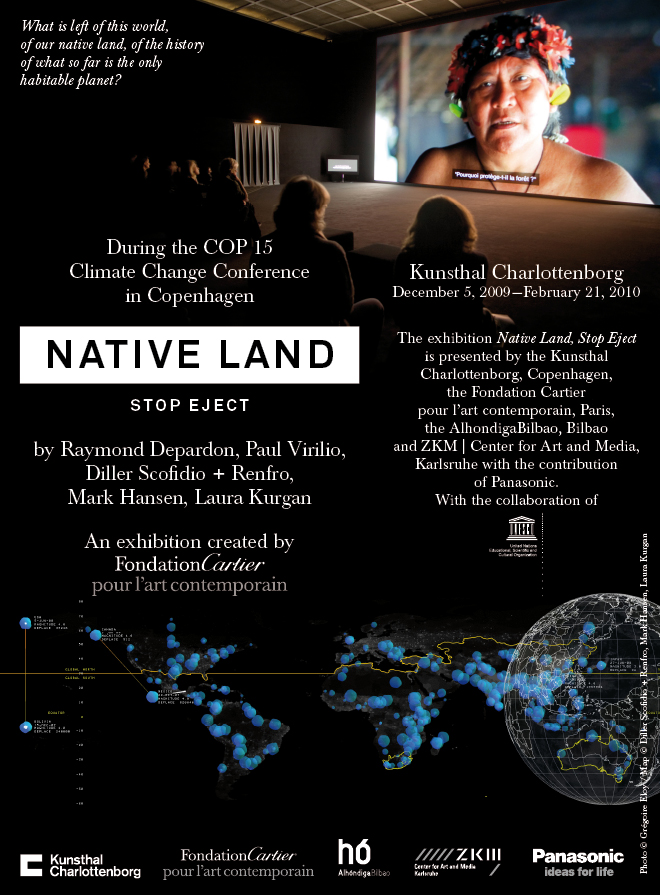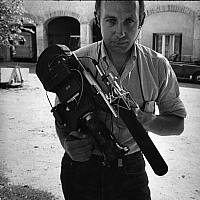
Fondation Cartier pour l'Art Contemporain 261, Boulevard Raspail 75014 Paris France
Created by the Fondation Cartier pour l’art contemporain, Native Land, Stop Eject explores the meaning of sedentariness and nomadism today, an epoch in which human migration flows are taking place on an unprecedented scale. It proposes a reflection on the notions of being rooted and uprooted, as well as related questions of identity. Filmmaker Raymond Depardon gives a voice to those who wish to remain on their land but are threatened with exile. Philosopher Paul Virilio, in collaboration with the artists architects Diller Scofidio + Renfro, Mark Hansen, and Laura Kurgan, examines and challenges new trends in contemporary human movement due to environmental, political, and economic factors.
HEAR THEM SPEAK by Raymond Depardon (with the sound engineer, Claudine Nougaret) is centred on nomads, farmers, islanders, and indigenous peoples, all of whom are either threatened with extinction or living on the periphery of globalization. Giving value to speaking and listening, he focuses on their mother tongue languages; though still spoken today, all the languages heard in the film are endangered, symbolizing the imminent threat to their identity: Kawésqar; Mapuche; Afar; Quechua; Chipaya; Breton; Occitan; Yanomami; Guarani.
EXIT, an innovative installation by Diller Scofidio + Renfro, Mark Hansen, and Laura Kurgan, gives form to Paul Virilio’s concepts on human trajectories across the globe. It displays a dynamic mapping of a database of information provided by international organizations through 6 animated maps: Population Shifts: Cities; Remittances: Sending Money Home; Political Refugees and Forced Migration; Natural Catastrophes; Rising Seas, Sinking Cities; Speechless and Deforestation.
Chief Curator: Hervé Chandès, General Director of the Fondation Cartier pour l’art contemporain, Paris.
The exhibition Native Land, Stop Eject has benefited from the participation of François Gemenne, researcher and professor of migratory movement linked to climate change.
The map “Speechless and Deforestation” has benefited from the scientific collaboration of Bruce Albert, Director of Research at the Institut de Recherche pour le développement, and François-Michel Le Tourneau, Director of Research at the Centre national de la recherche scientifique.
The following organizations have helped us in our acquisition of data. They have not, however, been asked to vouch for or endorse the content of this exhibition.
Carbon Dioxide Information Analysis Center, Oak Ridge National Laboratory; Center for International Earth Science Information Network (CIESIN), Columbia University; Centre for Research on Epidemiology of Disasters (CRED), École de Santé Publique, Université catholique de Louvain (EM-DAT database); Dartmouth Flood Observatory; Development Research Centre on Migration, Globalisation and Poverty (Migration DRC), University of Sussex; Fire Information for Resource Management and Global Land Cover Facility, University of Maryland; Global Forest Watch (GFW); Instituto Socioambiental (ISA); International Fund for Agricultural Development (IFAD); International Work Group for Indigenous Affairs (IWGIA); Komunitas Konservasi Indonesia WARSI (KKI WARSI); Model for the Assessment of Greenhouse-gas Induced Climate Change, A Regional Climate SCENario GENerator; South Dakota State University, Global Forest Monitoring Project System; Toyama University; UNESCO, Atlas of the World’s Languages in Danger, 2009; United Nations High Commissioner for Refugees (UNHCR); Wildlife Conservation Society (WCS) and CIESIN, Last of the Wild project.

